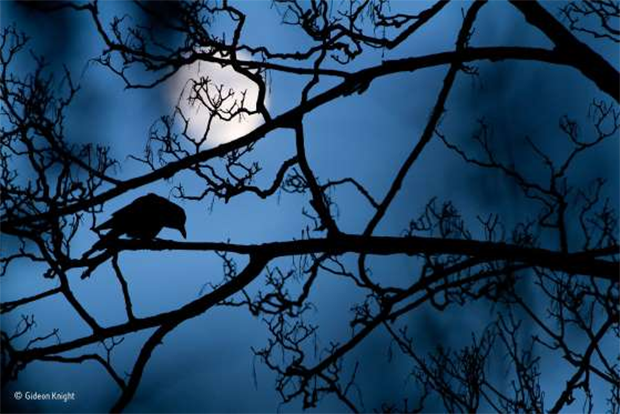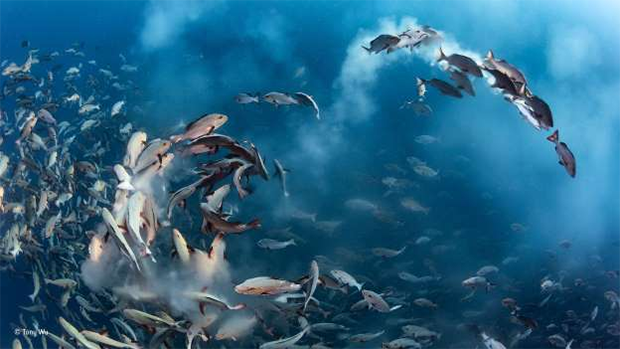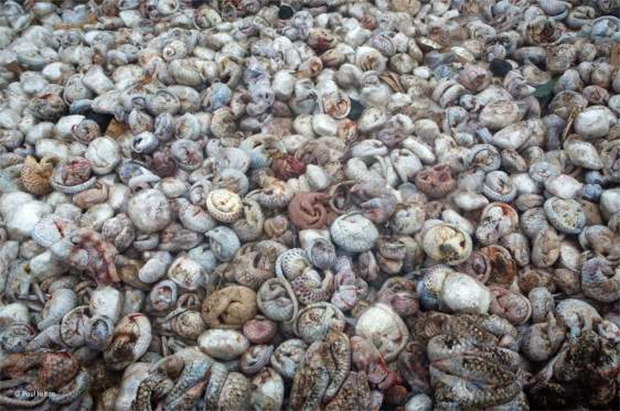|
The winners of the Wildlife Photographer of the Year Competition were
revealed at a ceremony at the Natural History Museum, London on Oct. 18.
American photographer Tim Laman won the prestigious award for his image
'Entwined lives' (pictured), which frames a critically endangered
Bornean orangutan above the Indonesian rainforest.
Beating almost 50,000 entries from 95 countries, Tim’s image will be on
show with 99 other shots selected by an international panel of judges at
the fifty-second Wildlife Photographer of the Year exhibition. It opens
at the Natural History Museum on Oct. 21, 2016 before touring across the
UK and internationally to locations such as Spain, Canada, the USA,
Germany and Macau.
|
|
Entwined lives
A young male orangutan makes the 100-foot (30-m) climb up the thickest
root of the strangler fig, high above the canopy in Gunung Palung
National Park, in West Kalimantan, one of the few protected orangutan
strongholds in Indonesian Borneo. Tim had to do three days of climbing
up and down himself, by rope, to place in position several GoPro cameras
that he could trigger remotely to give him a chance of not only a
wide‑angle view of the forest below but also a view of the orangutan’s
face from above. This shot was the one he had long visualized, looking
down on the orangutan within its forest home. |
|
 |
|
The moon and the crow
By Gideon Knight, Winner of Young Wildlife Photographer of the Year 2016
A crow in a tree in a park: a common enough scene. It was one that
Gideon had seen many times near his home in London’s Valentines Park,
which he visits regularly to take photographs. But as the blue light of
dusk crept in and the full moon rose, the scene transformed. The spindly
twigs of the sycamore tree silhouetted against the sky "made it feel
almost supernatural, like something out of a fairy tale," says Gideon. |
|

|
|
Eviction attempt
By Ganesh H Shankar, Winner of the Birds category
These Indian rose-ringed parakeets were not happy. They had returned to
their roosting and nesting hole high up in a tree in India’s Keoladeo
National Park (also known as Bharatpur Bird Sanctuary) to find that a
Bengal monitor lizard had taken up residence. The birds immediately set
about trying to evict the squatter, biting the monitor lizard’s tail,
hanging on for a couple of seconds at a time, until it retreated into
the hole. They would then harass it when it tried to come out to bask.
This went on for two days. But the action only lasted a couple of
seconds at a time and was fast-moving. |
|

|
|
Wind composition
By Valter Binotto, Winner of the Plants and Fungi category
With every gust of wind, showers of pollen were released, lit up by the
winter sunshine. The hazel tree was near Valter’s home in northern
Italy, and to create the dark background, he positioned himself to
backlight the flowers. The pollen-producing catkins open early in the
year, before the leaves are out, and release huge amounts of pollen to
be carried away by the wind. "The hardest part was capturing the female
flowers motionless while the catkins were moving," explains Valter. "I
searched for flowers on a short branch that was more stable." Using a
long exposure to capture the pollen’s flight and a reflector to
highlight the catkins, he took many pictures before the wind finally
delivered the composition he had in mind. |
|
 |
|
The alley cat
By Nayan Khanolkar, Winner of the Urban category
At night, in the Aarey Milk Colony in a suburb of Mumbai bordering
Sanjay Gandhi National Park, leopards slip ghost-like through the maze
of alleys, looking for food (especially stray dogs). Despite close
encounters and occasional attacks, the cats are an accepted part of the
lives and culture of the Warli people, seen in the traditional paintings
that decorate the walls of their homes. With growing human-leopard
conflicts elsewhere grabbing the headlines, Nayan was determined to use
his pictures to show how things can be different with tolerance and
planning. Positioning his flashes to mimic the alley’s usual lighting
and his camera so that a passing cat would not dominate the frame, he
finally – after four months – got the shot he wanted. With a fleeting
look of inquiry in the direction of the camera click, a leopard went
about its business alongside people’s homes.
|
|
 |
|
Requiem for an owl
By Mats Andersson, Winner of the Black and White category
Every day in early spring, Mats walked in the forest near his home in
Bashult, southern Sweden, enjoying the company of a pair of Eurasian
pygmy owls – until the night he found one of them lying dead on the
forest floor. Pygmy owls, with their distinctive rounded heads and lack
of ear tufts, are the smallest owls in Europe, barely 7.5 inches (19 cm)
long, though with large feet that enable them to carry prey almost as
big as themselves. "The owl’s resting posture reflected my sadness for
its lost companion," recalls Mats. Preferring to work in black and white
– "it conveys the feeling better" – he captured the melancholy of the
moment, framing the solitary owl within the bare branches, lit by the
first light of dawn.
|
|
 |
|
Snapper party
By Tony Wu, Winner of the Underwater category.
For several days each month, thousands of two‑spot red snappers gather
to spawn around Palau in the western Pacific Ocean. The action is
intense as the fish fill the water with sperm and eggs, and predators
arrive to take advantage of the bounty. The currents were unrelenting –
ideal for eggs to be swept swiftly away but a struggle for Wu to keep up
with the fast‑moving fish. Noticing that the spawning ran ‘like a chain
reaction up and down the mass of fish’, he positioned himself so that
the action came to him. On this occasion, with perfect anticipation, he
managed to capture a dynamic arc of spawning fish amid clouds of eggs in
the oblique morning light.
|
|
 |
|
The sand canvas
By Rudi Sebastian, Winner of the Details category.
The pristine white sand of Brazil’s Lençóis Maranhenses National Park
offers a blank canvas to the rain. In the dry season, sand from the
coast is blown by powerful Atlantic winds as far as 30 miles (50 km)
inland, sculpting a vast expanse of crescent-shaped dunes up to 130 feet
(40 m) high. With the onset of the rains, an impermeable layer beneath
the sand allows water to collect in the dune valleys, forming thousands
of transient lagoons, some more than 295 feet (90 m) long. Bacteria and
algae tint the clear water in countless shades of green and blue, while
streams carrying sediment from the distant rainforest make their mark
with browns and blacks. Patterns appear as the water evaporates, leaving
behind organic remains. Rudi waited several days for the perfect light –
overhead, to bring out the colors but with clouds obscuring any direct
sun ‘to get a shadowless purity’. Shooting almost vertically down from a
small aircraft with the door removed, avoiding perspective or scale, he
created his striking image. |
|
 |
|
Star player
By Luis Javier Sandoval, Winner of the Impressions category.
As soon as Luis slipped into the water, the curious young California sea
lions came over for a better look. One of the pups dived down, swimming
gracefully with its strong fore-flippers. It grabbed a starfish from the
bottom and started throwing it to Luis. "I love the way sea lions
interact with divers and how smart they are," says Luis. As the pup was
playing very close to the breaking point of the waves, Luis’s timing had
to be spot-on to frame it in the right place against the movement of the
water. Angling his camera up towards the dawn light – just as the pup
offered him the starfish and another youngster slipped by close to the
rocks – he created his artistic impression of the sea lion’s playful
nature.
|
|
 |
|
The pangolin pit
By Paul Hilton, Winner of the The Wildlife Photojournalist Award: Single
image category.
Nothing prepared Paul for the sight of 4,000 defrosting pangolins (5
tons) from one of the largest seizures of the animals on record. They
were destined for China and Vietnam for the exotic‑meat trade or for
traditional medicine (their scales are thought, wrongly, to treat a
variety of ailments). Pangolins have become the world’s most trafficked
animals, with all eight species targeted. This illegal trade, along with
habitat loss and local hunting, means that the four Asian species are
now endangered or critically endangered, and Africa’s four species are
heading that way. "Wildlife crime is big business," says Paul. "It will
stop only when the demand stops."
|
|
 |